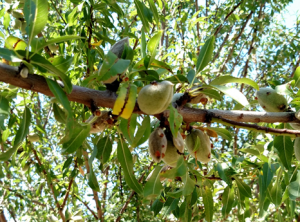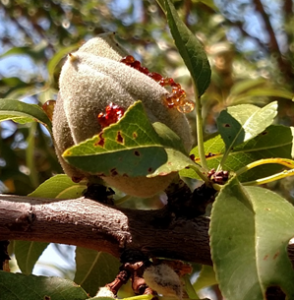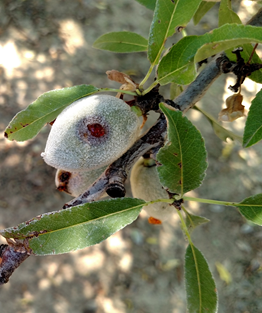While the disease bacterial spot has been identified in California since 2013, up until this year it was known only to occur in the northern San Joaquin Valley and as far north as Arbuckle. However, I was recently called out to a symptomatic orchard in Butte county and confirmed that bacterial spot was present.
Bacterial spot causes almond lesions that progress to exuding many spots and strings of gumming. Below are some of the photos that I took while out at the orchard:

‘Fritz’ almond showing symptoms of bacterial spot. Photo credit: D. Lightle.

Amber gumming symptoms on ‘Fritz’ almonds caused by bacterial spot. Note the long string of gumming on the top of this almond. Photo credit: D. Lightle.

Nut lesion and gumming caused by bacterial spot. Note that the leaf lesions in this particular orchard were diagnosed as alteraria, not bacterial spot. Photo credit: D. Lightle.
‘Fritz’ seems to be the most affected variety, and the above photos are indeed Fritz almonds. Other varieties that have shown symptoms include ‘Nonpareil’, ‘Butte’, ‘Carmel’, ‘Monterey’, and ‘Price’, though at lower levels. In the orchard I sampled, the Nonpareil and other pollinator rows were asymptomatic.
As the name implies, the causal agent of bacterial spot is the bacterium Xanthomonas arboricola pv. pruni. It likely overwinters in symptomatic mummy fruits and spreads with warm weather combined with rains the following season.
Research into control is still just beginning, but efficacy has been achieved with a program of: delayed dormant copper+mancozeb and in-season copper alone or copper + mancozeb in mid-March prior to rain & warm conditions. In-season treatments should be timed before temperatures are above 77ºF.
See this article for more information on what we know so far about bacterial spot.


Leave a Reply